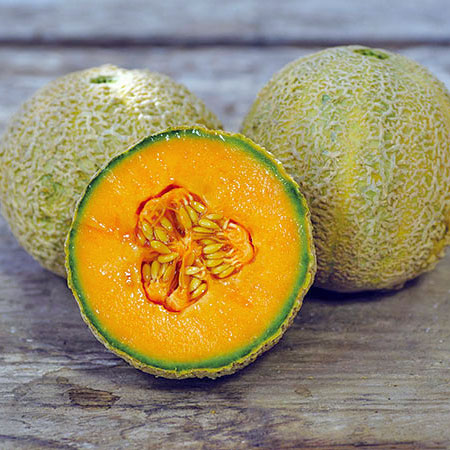Description
Honey Rock Cantaloupe (A.K.A. Sugar Rock)
25 Seeds per pack
Days to Maturity: 80-88 days
Sun Requirements: Full Sun
Botanical Name: (Cucumis melo)
Honey Rock is an early-maturing heirloom cantaloupe introduced in 1925 and bred by Michigan State University in cooperation with the USDA. It quickly gained popularity for its sweet flavor, firm texture, and productive yields—and won the All-America Selections award in 1933. The compact, nearly round fruits weigh 3–4 pounds and have a tough, gray-green rind with coarse netting. Inside, the salmon-orange flesh is juicy, tender, and wonderfully sweet, with that classic cantaloupe aroma and flavor.
Vines are strong, productive, and manageably sized, typically reaching 12–18 inches tall and spreading up to 6 feet—typically producing 5–7 fruits per plant. Especially well-suited to Northern gardens, including Michigan and Southeastern Canada, Honey Rock is known for its adaptability and resistance to Fusarium Wilt.
Honey Rock brings back the flavor of classic American melons—a perfect choice for home growers who want a delicious, sugar free summer treat!
Disease resistance: Fusarium Wilt
Planting Instructions for Honey Rock Cantaloupe Seeds
When to Plant:
Direct sow Honey Rock Cantaloupe seeds outdoors 1 to 2 weeks after your last frost date, once the soil consistently reaches 70°F (21°C) or warmer. For shorter seasons or cooler regions, start seeds indoors 4 to 6 weeks before last frost, using peat pots or soil blocks to avoid root disturbance. Transplant outdoors after hardening off and when both soil and air temperatures are consistently warm and the danger of frost is past.
Where to Plant:
Choose a site in full sun that receives at least 8 hours of direct sunlight daily. Honey Rock Cantaloupes thrive in fertile, well-drained soil with a pH of 6.0–7.0. Raised beds or south-facing slopes are ideal. Incorporate 2–3 inches of compost before planting. Avoid planting in areas that recently grew other melons, cucumbers, squash, or pumpkins.
How to Sow:
Sow seeds ½” to 1″ deep. If planting in rows, space seeds or transplants 18–36″ apart in rows 5–6′ apart. For hills, sow 3–4 seeds per hill and thin to the strongest 1–2 plants. For trellising, space plants 12–18″ apart along a sturdy support.
Watering:
Keep soil consistently moist through germination. Once vines are established, provide 1–2 inches of water per week. Water deeply and less frequently to encourage deep rooting. Reduce watering slightly once fruit begins to ripen to improve sweetness and avoid splitting. Avoid overhead watering to reduce the risk of mildew.
Fertilization:
Mix compost into the planting site before sowing. Additional fertilizer is typically not needed unless soil is poor. If desired, side-dress with compost tea, fish emulsion, or a balanced organic fertilizer once vines begin to spread and again when the first small fruits begin to form.
Mulching:
Once your seedlings are growing well, add mulch around the plants. Use black plastic if your goal is to warm the soil. Warmer soil helps seeds sprout faster and encourages early root and vine growth, which is especially helpful in cooler climates or early in the season. If you’re mainly trying to hold in moisture and stop weeds, straw or shredded leaves are good options, but they won’t help the soil warm up as much. Mulching also keeps the fruits clean by lifting them off the dirt and helps stop mud from splashing onto them when it rains.
Training & Pruning:
Vines can be allowed to sprawl or trained vertically. For vertical growth, support fruit with cloth slings. If desired, lightly prune some of the small side branches that grow off the main vine to help air move through the plant and let it focus energy on growing better-quality fruits. Avoid over-pruning, which can reduce flower production and sugar development.
Pollination:
Honey Rock Cantaloupes produce both male and female flowers. Bees and other pollinators are essential for fruit set. Encourage pollination by planting pollinator-friendly flowers and herbs nearby. Good choices include borage, dill, sunflowers, marigolds, and oregano allowed to flower. These help attract bees and other insects that will visit your Honey Rock Cantaloupe blooms. In low-pollinator areas, hand pollinate by transferring pollen from male to female blooms using a small paintbrush.
Common Pests & Diseases:
- Pests: Watch for aphids, cucumber beetles (vector for bacterial wilt), squash bugs, and vine borers. Use row covers until flowering, hand-pick pests, or apply insecticidal soap in the early morning or evening.
- Diseases: Powdery mildew, downy mildew, and leaf blights can occur. Improve air circulation, avoid overhead watering, and space plants adequately. Treat outbreaks with organic fungicides or DIY sprays (e.g., baking soda solution).
Harvesting:
Honey Rock Cantaloupes are ready to harvest when the rind is well-netted and the skin turns pale green to buff between the netting. The fruit should slip easily from the vine with light pressure. A sweet, rich aroma and slight softness at the blossom end also signal ripeness. For best results, harvest in the cool of morning after the fruit’s stem tendril has completely dried.
Storage:
Store ripe, uncut Honey Rock Cantaloupes at 45–50°F for up to 1 week. Once cut, refrigerate and use within 3 days. Wash melons thoroughly before cutting to avoid transferring bacteria from rind to flesh.
Seed Saving:
Saving Honey Rock Cantaloupe seeds is an enjoyable and economical way to preserve this classic heirloom variety. Honey Rock Cantaloupes are insect-pollinated and cross readily with other melon types, so avoid growing multiple melon varieties within ½ mile of one another.
Let the melons ripen fully on the vine. Once picked, cut them open the long way and scoop out the seeds into a jar. Add room temperature (not hot) water and let the mixture sit for 2 to 4 days, stirring it once each day to help the seeds separate. Good seeds will sink, while pulp and non-viable seeds float. Pour off the debris, rinse the good seeds thoroughly, and spread them out on a paper towel or mesh screen to dry for several days in a well-ventilated area.
Once your seeds are fully dry, you can store them in a labeled container. For longer storage, you can keep the container right in the freezer. Freezing helps protect seeds from moisture, pests, and temperature swings, especially over many months. For a quick and easy option, use our seed-saving envelopes. They’re simple to use, pre-labeled, and include spaces to write the variety, date, and any notes you want to remember. They help keep your seeds neat, labeled, and easy to find when you’re ready to plant next season. When stored properly, Honey Rock Cantaloupe seeds can last 3–5 years.
FAQ:
What is the historical or notable background of Honey Rock Cantaloupe?
Honey Rock Cantaloupe was introduced in 1925 by Michigan State University in collaboration with the USDA. This early-maturing heirloom quickly became popular for its sweet flavor and high yields, and it won the prestigious All-America Selections award in 1933.
How would you describe the flavor of Honey Rock Cantaloupe?
Honey Rock Cantaloupe is known for its juicy, salmon-orange flesh that delivers a wonderfully sweet, rich flavor and classic cantaloupe aroma—making it a favorite for fresh summer eating.
What does Honey Rock Cantaloupe look like, and what are its growing habits?
The fruits are compact, nearly round, and weigh 3–4 pounds. They have a gray-green rind with coarse netting. The vines are strong yet manageably sized, growing 12–18 inches tall and spreading up to 6 feet, typically producing 5–7 melons per plant.
How and when do I harvest Honey Rock Cantaloupe?
Harvest Honey Rock when the rind is heavily netted and the background color shifts from green to a buff or gray-green hue. The fruit should slip easily from the vine with light pressure. A sweet, musky aroma and gentle softness at the blossom end also indicate peak ripeness.
When is the best time to plant Honey Rock Cantaloupe?
Plant outdoors 1–2 weeks after your last frost, once soil temperatures reach at least 70°F. In cooler climates, start seeds indoors 4–6 weeks before the last frost and transplant after danger of frost has passed.
What are the common culinary uses for Honey Rock Cantaloupe?
This cantaloupe shines in fruit salads, smoothies, sorbets, or simply chilled and eaten fresh. Its rich sweetness also pairs well with savory dishes like prosciutto-wrapped melon.
What’s the best way to store Honey Rock Cantaloupe after harvest?
Uncut, ripe melons store well at 45–50°F for up to one week. Once cut, refrigerate and use within 3 days. Always wash the outer rind before slicing to prevent transferring any bacteria to the fruit.
What nutrients does Honey Rock Cantaloupe provide?
Honey Rock is rich in vitamins A and C, beta-carotene, and hydration-boosting electrolytes, making it a refreshing and nutritious choice during hot summer months.
Does Honey Rock Cantaloupe have any notable disease resistance?
Yes, it is resistant to Fusarium Wilt, a common soil-borne disease that can devastate melon crops, especially in regions with a history of melon planting.


















Coit Frandsen (verified owner) –
Amazing seeds
Steve Johnson (verified owner) –
Excellent company – Everything comes out as expected.
Gail Olsen (verified owner) –
All my favorites from one shop is a time saver. Fast shipping and good value.
Becky (verified owner) –
All seeds planted have sprouted! Looking forward to trying some cantelope this summer!
Kathy (verified owner) –
Cantaloupe don’t get any better than this.
Lauren Campbell (verified owner) –
3 star!